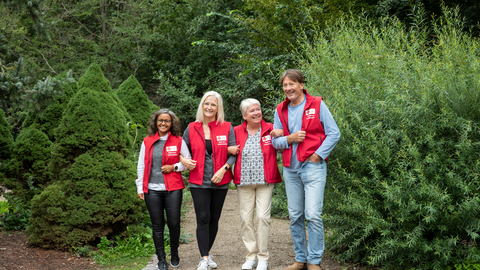Collaboration makes sense in the Red Cross Asylum Department
Collaboration makes sense in the Red Cross Asylum Department
Good collaboration with businesses, clubs and societies creates better opportunities for asylum seekers

When Red Cross focuses on collaboration, it is first and foremost because it can lead to better activities and conditions for the asylum seekers. Here are just a few examples:
”When we are good at collaborating with local clubs and societies, asylum seekers are able to play sports or attend other good activities in the local area, when our employees are good at making deals with local businesses, more people can get work experience placements, for example, and when we cooperate with other organisations, we can invite more volunteers to create positive experiences for our asylum seekers,” Anne la Cour, Head of the Asylum Department, explains. ”It is all about what is most relevant to the asylum seekers in the places where we happen to have asylum centres,” she says.
Collaboration takes place on many different levels
”We have always had to speak to everybody. We talk to the officials in the Danish Immigration Service about contacts and conditions in our schools, for example, we cooperate with the Danish Refugee Council on the need for counselling for our residents concerning their asylum cases, we talk to local volunteers, both from Red Cross and other organisations, and we speak with CEOs of large companies about donations and partnership agreements. The asylum field is an area of constant development, and it is therefore important to have an ongoing dialogue with everyone,” Anne la Cour explains.
The right match for the Red Cross asylum centres
The latter example with companies is something with which Kasper Koch, Head of Strategy & Development, has a lot of experience. When businesses contact the Red Cross Asylum Department with a view to collaboration, a large effort is made to create the right match between the individual company and the Red Cross asylum centres:
”We set up a close collaboration with the individual company to see how their expertise and product can create a better everyday life for the residents in the asylum centres. It has to be the right match so that everyone benefits,” Kasper Koch explains.
Good collaboration can lead to more
One example of a good match is IKEA. In the spring of 2014, IKEA contacted the Red Cross Asylum Department. The company wanted to send a group of young people from the asylum centres on a folk high school course. This resulted in a fantastic stay for 27 young people and led to even more collaboration in September 2015, when the Auderød Centre just outside Frederiksværk had to open in a hurry.
”IKEA provided sofas, shelves and tables, so that we could furnish four living rooms for the residents of the asylum centre. That sort of thing makes a huge difference when a drab, grey concrete building has to be turned into a home for several hundred asylum seekers in no time,”Kasper Koch says.
Local collaboration on work experience for asylum seeekers
At the Kongelunden Centre on Amager close to København, the track record of collaborating with local businesses is also good. Over the past year, the asylum centre has set up a partnership with two local tradesmen, giving a couple of the residents an agreement about a work experience placement.
"We want to set up work experience agreements for the residents in the asylum centre, so that they get a better chance of providing for themselves. Today, some of the residents in the Kongelunden Centre work as trainees with the local car mechanic and the local electrician,” Kasper Koch says.
”All asylum seekers can join in, as long as everyone benefits from it, and we have become really good at finding obvious matches which are relevant to all the parties involved. If anyone is interested, just send me a mail: kpk@redcross.dk,” Kasper Koch concludes with a convincing smile.